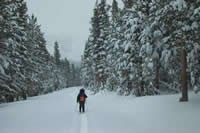
NPS Photo December 2003 Entrance Stations Now Accept Credit Cards Previously, visitors had to pay the $20 entrance fee by cash or check. Yosemite National Park management recognized that providing another option to cover the entrance fee would be a beneficial service for park visitors. With the availability of other payment methods, many travelers today carry very little money. The option to pay by credit card provides additional flexibility to visitors to the park. Visa, MasterCard, American Express, Discover, and Diners Club cards have been accepted at park entrance stations since December 10. "We are very excited to provide this service to visitors of the park," said Mike Tollefson, Superintendent of Yosemite National Park. "It gives them a choice and helps make their trip planning simpler." Tuolumne Meadows in Winter: Population 2 When the Tioga Road closes in late fall, winter rangers Bruce & Tracey Wiese get busy! They assist cross-country skiers, observe wildlife activity, regularly assess avalanche conditions, survey the Sierra snow pack, and when needed, assist in search & rescues. They get around only on cross-country skis and can log up to 1,000 miles in a season! Periodically, the winter rangers send in reports from their Tuolumne Meadows base. What follows is their latest installment. Report from Tuolumne Meadows WEATHER/SNOW (from Dec. 11 to Dec. 18) SKIING CONDITIONS AVALANCHE/SNOW CONDITIONS (above 8,000’) We noticed that a few small avalanches had occurred early in the week, mostly involving last Sunday morning’s new snowfall. Sunday’s storm had strong SW winds and several slides had started from wind deposited snow off of steep rocky starting zones. We have also seen evidence in some steeper, rocky areas of other small slides, which appear to be sloughing after every storm exposing the gray colored old, November snow surface. Our snow pit tests on Unicorn Peak (near last week’s test area) showed weaknesses about 6” down (bottom of freshest snow) and another weakness several feet down on top of the old November ice crust. Both a stuffblock test (dropping a ten-pound bag on an isolated shovel size snow column) and a rutschblock test showed moderate instabilities at both these depths. The bottom layer of faceted snow had been somewhat compressed and generally more compacted than a week ago. The overlying snow may have helped compact this layer, but having facets at this depth is always a red flag, one we will have to consider throughout this winter. WILDLIFE Although flying squirrels live in the Sierra, it is not common to see these much more secretive critters. But we see a fair amount of falling squirrels and even more of their tracks. One day just as a snow storm had subsided and the trees were falling with squirrels, we saw a goshawk perched in a tree next to the Tioga Road; it looked like a good time and place to catch a meal as it floundered in the snow trying to cross the open road. The falling squirrel prints look similar to snowball impressions in the snow, since their landing is in a tight four-point stance. While working one winter in Glacier National Park, we would use a much more revealing impression left by pine martens and fishers when they leaped from a tree, indicating body length and width, even head and tail impressions in favorable conditions. The dimensions would often help determine which species made the track. Note: The Tuolumne Meadows Winter Conditions Update is posted every week at https://www.nps.gov/yose/now/tm.htm. |
Last updated: March 1, 2015
